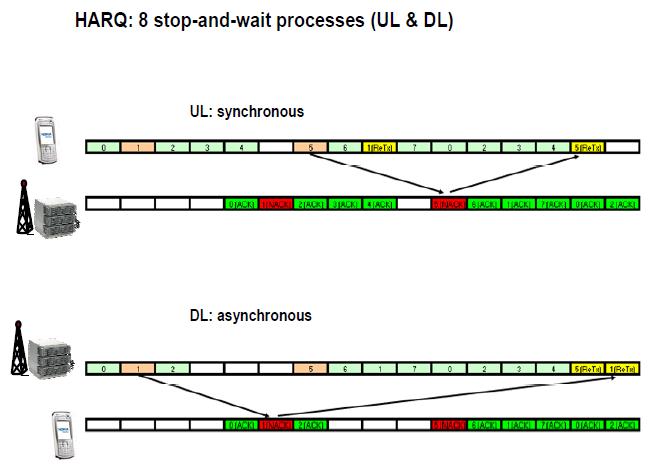Hybrid ARQ (HARQ) leads to higher efficiency in transmission and error correction.
There is one HARQ entity per UE with 8 stop-and-wait processes for each HARQ
entity. Both incremental redundancy and chase combining are supported. The
number of HARQ retransmissions targeted by the HARQ protocol depends on the
network configuration.
The BLER seen by RLC is much lower than the BLER seen by the HARQ protocol.
As an example, the HARQ protocol could be operated in a very persistent manner to
avoid RLC retransmissions as far as possible.
If a radio block fails due to the CRC evaluation, a retransmission is issued. L1 is used for signaling to indicate need for retransmission, a fast round trip time is facilitated between UE and BTS. But rather than erasing the failed bits they will remain in the soft memory buffer of the UE and are used to enhance detection of the retransmitted bits.
 The lower part of the MAC entity is the HARQ (Hybrid Automatic Retransmission on
The lower part of the MAC entity is the HARQ (Hybrid Automatic Retransmission on
reQuest) entity. Note that only certain transport channel types can have this unit.
 The assembled transport block from the multiplexer will be stored in one of the
The assembled transport block from the multiplexer will be stored in one of the
HARQ’s buffers and simultaneously sent to the physical layer:
• If the eNB/UE receives the transport block correctly, it will send an ACK indication
via a special physical channel. This would delete the transport channel from the
buffer.
• If no indication or a NACK indication is received, the HARQ entity will retransmit
the transport block. Both, UL and DL HARQ are based on an N-stop-and-wait processes.
A main difference between HARQ in UL and DL:
• UL: a synchronous mode is used
• DL deploys an adaptive, asynchronous HARQ.